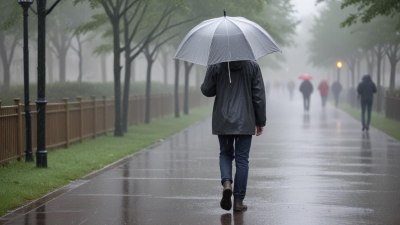Why That "Perfect Breeze" Is Never There When You Actually Need It
Exploring why the perfect breeze seems elusive when we need it most.

There's something inherently soothing about a perfect breeze — that gentle, refreshing gust that brings relief on a sweltering day or cools you down after a jog. Yet, it seems like this heavenly phenomenon is often absent when it's needed the most. Why does the perfect breeze elude us, leaving us to suffer in the heat or the stillness? In this article, we delve into the science of breezes, the psychology behind our perceptions of weather, and the many factors that contribute to the absence of that sought-after wind.
The Science of Wind
To understand why the perfect breeze is often unfound, it's essential to grasp the fundamentals of wind. Wind is caused by the uneven heating of the Earth's surface by the sun. Areas that heat up faster create areas of low pressure, while cooler areas create high pressure. Air moves from high to low pressure, creating wind. The factors contributing to wind include the topography of the landscape, the presence of bodies of water, and temperature differences between various regions.
Seasons and Wind Patterns
Seasonal changes also play a crucial role in wind formation. In summer, as the sun heats the ground, rising warm air can create updrafts that contribute to localized breezes. However, at times when you expect a gentle wind to whisk past, you may find the air stagnant and still. Changes in local weather patterns, such as high-pressure systems that dominate the landscape, can suppress this ideal breeze. In the winter months, cold air can create different wind patterns, leading to chilly gusts instead of the comforting warm breezes we long for.
The Influence of Geography
Geographical features significantly affect wind patterns. Urban areas are often surrounded by buildings that can disrupt and alter wind flow. Instead of the cool breeze we seek, the buildings can create wind tunnels or pockets of calm air. Conversely, open fields or coastal areas tend to have more reliable breezes due to their less obstructed landscapes. When you’re in a city, you may have to venture to parks or waterfronts to experience that optimal wind. This relationship between geography and wind serves as yet another reminder that the perfect breeze may not be attainable in all locations.
The Role of Temperature
Temperature is a critical aspect when it comes to the occurrence of breezes. When temperatures heat up, the air rises, leading to low-pressure areas that can create breezes if there's a nearby cooler area for air to flow into. However, on exceptionally hot days, the atmospheric conditions can lead to stagnant air, blocking the natural flow that generates a refreshing breeze. Conversely, when temperatures dip significantly, the wind can feel like a harsh chill rather than a perfect breeze. The quest for that comforting and refreshing air can often become a frustrating chase due to the myriad of temperature influences at play.
The Effect of Humidity
Humidity also plays a significant role in our experience of breezes. High humidity can make the air feel heavy, and in such conditions, breezes lose their refreshing quality as the moisture-laden air doesn't provide the cooling sensation we seek. Low humidity can produce the kind of crisp air that not only feels cool but can also invigorate the spirit. Hence, when seeking that ideal breeze, it’s essential to also consider the humidity levels that accompany it.
Psychological Aspect of Expectations
On a psychological level, our expectations regarding the weather can cloud our experiences. When we anticipate a refreshing breeze, our senses heighten, making us more aware of its absence. Studies in environmental psychology suggest that our emotional states can amplify our perceptions. When hot and longing for relief, our disappointment grows more acute if the anticipated breeze doesn’t arrive, making it seem even more elusive. This creates a cycle where our longing for a cool breeze may lead us to fixate on its absence, reinforcing the belief that it’s never there when we need it most.
Timing and Nature's Unpredictability
Another factor contributing to the apparent rarity of the perfect breeze is timing. Breezes can be fleeting and unpredictable, making their appearance contingent upon specific atmospheric conditions that may not align with our needs. Weather can change quickly, and the patterns that bring a breeze one moment may shift, leading to moments of calm. Nature’s unpredictability means that despite the science and meteorological forecasting in place, a breeze could appear just as easily as it may dissipate, reminding us of the capriciousness of the natural world. As a result, it becomes essential to remain adaptable and find ways to enjoy the still moments even when the wind is absent.
Finding Your Own Perfect Breeze
So, how can we seek out that elusive perfect breeze? Understanding the time of day when breezes are most likely to occur can be helpful. Typically, breezes are strongest in the late afternoon and early evening, following the heat of the day. Seeking out parks, natural reserves, or waterfronts can make a difference in capturing that refreshing air. Observing the local weather patterns, including wind forecasts, can also provide insights on when to expect that desired breeze. Given the elements we cannot control, finding avenues to bring that refreshing sensation to our lives can make our search for the perfect breeze more fulfilling, even if it is not consistently found.
Bringing the Breeze Indoors
If the weather outside turns out to be less than accommodating, consider ways to bring that perfect breeze indoors. Opening windows and doors to create cross-ventilation can mimic that outdoor breeze effect. Utilizing fans strategically can help circulate air and create that refreshing feel. Adding plants that add moisture into the air can also create a system that mimics natural breezes, working to lift the weight of stagnant indoor air.
In summary, the quest for that perfect breeze is a multifaceted journey influenced by science, geography, psychology, and personal expectations. The dance between high and low pressures, temperature changes, humidity levels, and the unpredictability of nature makes breezes a complex but enchanting subject. While it may feel like the perfect breeze is often elusive when we need it most, understanding the factors at play can enhance our appreciation for these fleeting moments of comfort and reprieve. Embracing the outdoor elements, exploring our surroundings, and learning to adapt will help us better recognize and savor those rare, refreshing breezes when they do come our way.











